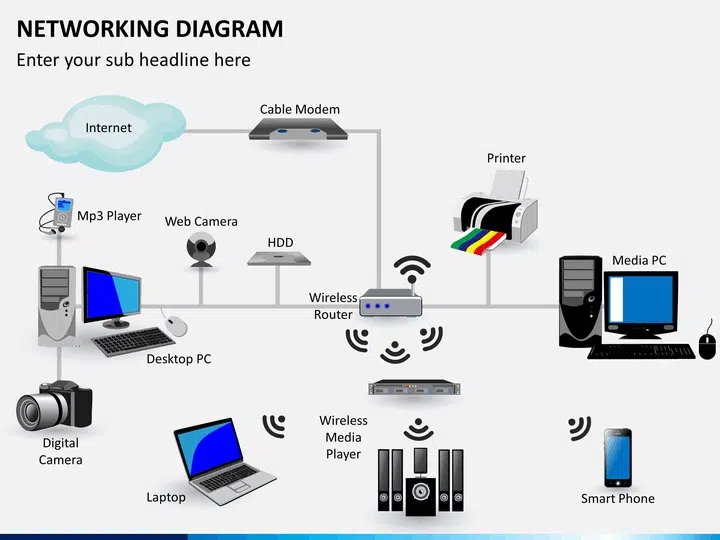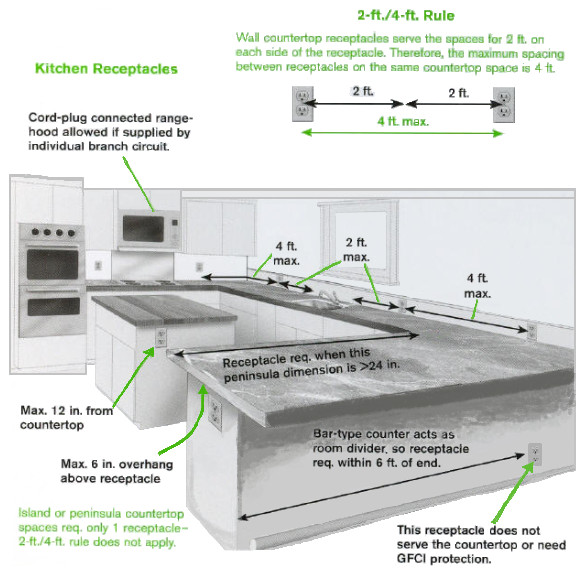GFCI, or ground fault circuit interrupter, outlets are a type of special outlet that is designed to protect people from electric shock. In the kitchen, it is important to have GFCI outlets installed as they can help prevent electrical hazards. All outlets in the kitchen should be GFCI-protected to ensure the highest level of safety for you and your family. GFCI outlets are designed to sense when an electrical current is going to the ground instead of flowing in the intended circuit. If this happens, the GFCI outlet will trip and stop the electricity from flowing. This is why GFCI outlets should be installed in all kitchen outlets, as they offer an extra layer of protection against electrical shocks.
Overview of GFCI Outlets
The electrical safety of any home is vital, and having the right outlets installed is key. GFCI outlets, or Ground Fault Circuit Interrupters, are an important part of any home or business’s electrical system. GFCI outlets are designed to protect against electrical shocks and short circuits and must be installed in certain areas of any home. So, do all outlets in the kitchen need to be GFCI outlets?
The short answer is yes – all outlets in the kitchen should be GFCI outlets. GFCI outlets are designed to detect any current leakage and automatically shut off the power in the event of a short circuit. This ensures that anyone using the outlet is safe from any kind of electrical shock. In the kitchen, the presence of water and other liquids increases the risk of an electrical shock, and GFCI outlets are the best way to protect against this.
GFCI outlets are also required in other areas of the home, such as bathrooms, basements, and laundry rooms. In addition, if the home has an outdoor electrical outlet, it should also be a GFCI outlet. It is important to check local building codes to ensure that all outlets in the home are up to code.
GFCI outlets can be easily installed by a qualified electrician, and they can provide peace of mind for any homeowner. With the right outlets in place, a home is much safer from potential electrical shocks and other dangers.
Benefits of GFCI Outlets
GFCI (Ground Fault Circuit Interruptor) outlets are an essential safety device in any home. They help to protect people from electric shock and other electrical hazards. On top of providing safety, GFCI outlets also offer additional benefits, such as improved energy efficiency and convenience.
The primary benefit of GFCI outlets is that they protect people from electric shock. They work by detecting any changes in electrical current and automatically shut off the circuit. This helps to prevent electric shock and other electrical hazards, such as fires. Additionally, GFCI outlets help to improve energy efficiency by preventing current leakage and reducing the amount of electricity used.
GFCI outlets also provide convenience. They can be installed anywhere, meaning you don’t need to find an outlet near a water source such as a sink or bathtub. Additionally, GFCI outlets are designed to be easy to use and require minimal maintenance.
It is important to note that all outlets in kitchens and bathrooms should be GFCI outlets. This is because they are areas where there is a higher risk of electric shock and other electrical hazards. Installing GFCI outlets in these rooms can help to protect people from electric shock and other electrical hazards.
In summary, GFCI outlets provide several important benefits, including improved safety, energy efficiency, and convenience. Installing GFCI outlets in all outlets in kitchens and bathrooms is essential for optimal safety and protection.
Installation Requirements
for GFCI Outlets
GFCI outlets are a must-have for any kitchen. They provide an extra layer of protection against electric shocks, making them a critical safety feature. But what are GFCI outlets and do all outlets in the kitchen need to be GFCI?
GFCI stands for Ground Fault Circuit Interrupter and they are required by the National Electrical Code in kitchens, bathrooms, and other wet areas. GFCI outlets detect any unusual electrical current, such as when an appliance is dropped into water. This interruption of the current helps prevent electric shock and protects those in the vicinity of the outlet.
GFCI outlets should be installed in all outlets in the kitchen, as well as in any outlets within 6 feet of a sink. This ensures that any water that comes into contact with any of the outlets is quickly isolated, reducing the risk of electric shock. The location of outlets in the kitchen is also important, as they should be placed away from any water sources, such as the sink and dishwasher.
GFCI outlets are relatively easy to install, and can even be done as a DIY project. However, it is always recommended to hire a professional electrician to ensure that the installation is done correctly and safely. Professional electricians can also help identify any other potential safety hazards in the kitchen and recommend solutions that will keep you and your family safe.

Credit: thenetworkinstallers.com
Cost Considerations
When it comes to installing GFCI outlets in your kitchen, cost is always a factor. Although GFCI outlets are generally more expensive than regular outlets, they can be a worthwhile investment. GFCI outlets help prevent electrical shock and can be a lifesaving measure for those living in an older home with aged wiring. It’s important to note that GFCI outlets should be installed in any area where water is present, including the kitchen.
When it comes to cost, GFCI outlets can range from $10 to $20, and it’s important to factor in the cost of installation. An electrician may charge anywhere from $50 to $100 per outlet, depending on the complexity of the job. It’s also important to consider the cost of any additional materials that may be needed. For example, if the wiring is outdated, the electrician may need to update the wiring as well.
Overall, the cost of installing GFCI outlets in your kitchen varies depending on the number of outlets, the complexity of the job, and the cost of materials. When it comes to electrical safety, GFCI outlets are an important investment that can save your life and your property.
Troubleshooting GFCI Outlets
in Your Kitchen
Troubleshooting GFCI outlets in your kitchen can be a daunting prospect. GFCI outlets are a common feature in modern kitchens as a safety measure. They are designed to protect you and your family from electric shock and potential fires. But do all outlets in the kitchen need to be GFCI-protected? The answer is both yes and no.
Yes, all outlets in the kitchen that have direct contact with water or moisture must be GFCI-protected. This includes outlets near sinks, dishwashers, and other wet areas. However, outlets that don’t have direct contact with water do not necessarily need to be GFCI-protected.
If you’re not sure which outlets are GFCI-protected and which are not, there are a few easy ways to check. First, look for the “test” and “reset” buttons on the outlet. If these buttons are present, the outlet is GFCI-protected. Second, you can check the circuit breaker box for a GFCI breaker. Finally, you can use a voltage tester to check the outlet for ground fault protection.
Knowing which outlets in your kitchen are GFCI-protected is important for your safety. If you’re still unsure which outlets need to be protected, it’s best to call an electrician to help you troubleshoot and make sure your kitchen is safe.
Regulations Regarding GFCI Outlets
in Kitchen
A GFCI (Ground Fault Circuit Interrupter) outlet is a type of electrical outlet designed for safety and to protect against electrical shock. It is important to know that not all outlets in a kitchen need to be GFCI outlets; in fact, there may be some outlets that are not required to be GFCI outlets. Understanding the regulations regarding GFCI outlets in the kitchen can be confusing, so it is important to consult with a licensed electrician to ensure that the outlet is installed and wired correctly.
In the United States, GFCI outlets are required in any area of the home where water is present, including kitchens. This includes areas such as the sink, dishwasher, and refrigerator. Any outlet within six feet of a sink must be a GFCI outlet. Also, any outlet within two feet of a wet bar sink must be a GFCI outlet. Any outlet located in a garage or outdoor area must be a GFCI outlet as well.
In addition to the areas where GFCI outlets are required, there are also areas where they may be used but are not required. These areas include countertop outlets, islands, pantries, and built-in appliances. Although GFCI outlets are not required in these areas, they are still a great safety precaution and could prevent accidents.
It is important to understand the regulations regarding GFCI outlets in the kitchen to ensure that your home is up to code. By consulting with a licensed electrician, you can make sure that your outlets are installed correctly and that you are in compliance with local regulations.
Considerations for Older Homes
When living in an older home, one of the most important considerations for electrical safety is whether or not all outlets in the kitchen need to be GFCI outlets. GFCI outlets are designed to protect people from shocks and electrocution by automatically shutting off the power when an electric current is detected. In newer homes, GFCIs are required in all areas where water is present, including the kitchen. However, in older homes, this may not be the case.
When renovating an older home, it is important to assess the current wiring and outlets to determine if they need to be replaced with GFCI outlets. If the existing outlets are not GFCI outlets, a licensed electrician should be consulted to make sure that the installation of GFCI outlets meets all applicable code requirements. Additionally, any outlets that are not GFCI outlets should be checked regularly to ensure that they are in proper working order.
Finally, it is important to note that GFCI outlets are not a substitute for proper electrical safety practices. All outlets in the kitchen should be checked regularly to ensure that they are not overloaded and that all cords are in good condition. Additionally, any kitchen appliances that are plugged in should be inspected regularly to make sure that they are in good working order.
GFCI outlets are an important part of electrical safety in all homes, especially in older homes. By assessing the existing wiring and outlets and consulting a licensed electrician, homeowners can ensure that their kitchen outlets are up to code and safe for use.
Conclusion
Yes, all outlets in the kitchen should be GFCI to ensure the safety of the home and its inhabitants. GFCI outlets provide additional protection against electrical shock, which is particularly important in wet environments like the kitchen. Furthermore, GFCI outlets are now mandated by the National Electric Code in all areas where there is a potential for water or moisture to come into contact with electrical outlets. For these reasons, it is important to ensure that all outlets in the kitchen are GFCI-protected.


